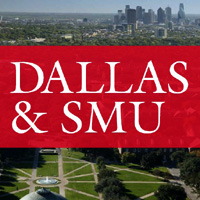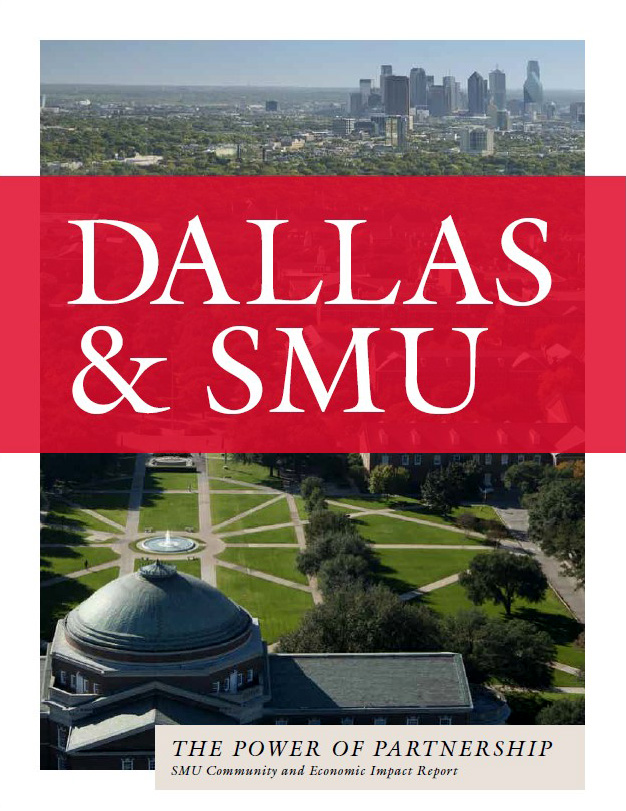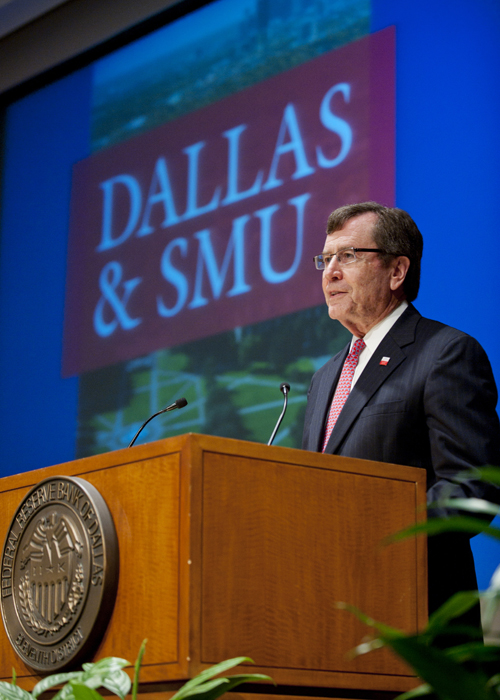Report describes SMU’s significant impact on DFW region
A new report describes the significant impact of SMU on the DFW region.

 See a summary of the report Read the full report. |
Richard Fisher, president and CEO of the Federal Reserve Bank of Dallas, made welcoming remarks. SMU President R. Gerald Turner presented the report. The event included remarks by SMU Board Chair Caren Prothro and trustees Carl Sewell, Ray L. Hunt, and Michael Boone, vice chair of the SMU Board and chair of the Community Relations Committee of SMU’s Centennial commemoration, which will culminate in 2015, the centennial of the University’s opening.
Information in the report ranges from the regional economic impact of SMU to changes in the student profile, along with research, cultural resources, public service and integration of community service into coursework.
“As part of our Centennial commemoration, we felt it was important to evaluate and highlight the return on investment Dallas has received by supporting the establishment of SMU 100 years ago,” said President Turner. “We hope the report provides a meaningful snapshot of our contributions, measured not only in financial terms but also in intellectual capital. Our goal is to continue to give back to the region that has helped to make SMU a national university worthy of this great city. We celebrate this productive partnership.”
Economic Impact
The economic impact section of the report was prepared by Dr. Bernard Weinstein, associate director of the Maguire Energy Institute in SMU’s Cox School of Business and an adjunct professor of business economics, and Dr. Terry Clower, director of the Center for Economic Development and Research at the University of North Texas.
Highlights of findings are:
- Impact of $861 million for the 2010-11 academic year from expenditures for the University’s operations and capital projects; spending by students, parents and visitors drawn to the region because of the University; and SMU expenditures for student scholarships. This impact supports a total of 6,300 jobs annually in the community. In addition, SMU directly employs 2,200 faculty and staff.
- A total impact of $7 billion, including the above and expenditures by SMU’s 40,000 alumni in the DFW region.
- Over a 20-year period, from 1995 through 2015, an impact of $2.2 billion resulting from capital projects in fulfillment of SMU’s master plan, including more than 40 new or renovated SMU buildings and facilities constructed thus far since 1995.
- University resources valued at $4 billion, including an endowment of $1.2 billion, in addition to real estate, buildings and equipment; art and special collections; and other assets.
In addition, SMU has raised more than $1.1 billion since 1995, creating 404 new endowed scholarships; 31 endowed faculty positions; 18 endowed schools, departments or institutes; as well as new or renovated facilities. The current fundraising effort, “SMU Unbridled: The Second Century Campaign,” is running concurrently with the Centennial commemoration period extending through 2015. To date the campaign has raised more than $610 million, or 81 percent of the $750 million goal.
“The impact report underscores SMU’s importance to Dallas and the region, including the contributions of academic, cultural and community service programs,” Prothro said. “DFW residents support SMU because they appreciate this impact. For example, of the 42,000 donors to SMU in the last 15 years, 23,000 did not attend the University, but they, like me, understand the value of a distinguished university in the heart of our city.”
Board of Trustees Vice Chair Boone said, “While Dallas can be very proud of what SMU has achieved so far, the University's future impact on the City and the region will be of much greater significance. SMU's academic presence and reputation will continue to ascend in a manner that brings much greater visibility and value to the region in the global marketplace.”
Growth of Programs Meeting Area Needs
The report also highlights the changing profile of the University, which opened in fall 1915 with 456 students and 37 faculty members. SMU today comprises seven schools offering 103 undergraduate degree programs, 104 master’s and 27 doctoral programs. The report notes that through the years SMU has established academic programs in direct response to city needs and opportunities, such as the schools of engineering, business, and most recently, education and human development. SMU also has established specialized institutes of particular interest to the region, such as those focusing on energy, global markets, and entrepreneurship.
Global Research
 SMU President R. Gerald Turner speaks about the report to some 400 business and civil leaders Tuesday at the Federal Reserve Bank of Dallas. He later talk about the report on KRLD Radio's CEO Spotlight with David Johnson. Hear the interview.  |
Also included in the report are highlights of research conducted locally and internationally by SMU faculty and students. This includes research to locate geothermal energy resources, improve water quality in developing countries, monitor the earth’s movement and explore the origins of the universe working with the global team of physicists at CERN in Switzerland. Other projects are aimed at identifying more effective drug therapies for Parkinson’s disease and developing artificial limbs that “feel.”
In the classroom, SMU maintains a student-faculty ratio of 11:1 to keep classes small and professors accessible for mentoring.
Changing Student Profile
One of the most dramatic changes at SMU has been in its enrollment. Applications for admission to SMU have steadily increased, and the average SAT score has risen 129 points since 1995. Diversity also has increased, with a minority undergraduate and graduate enrollment of 25 percent. Seventy percent of students receive some form of merit and/or need-based financial aid, including Federal Pell grants for the neediest students.
About 50 percent of SMU students come from outside of Texas, representing all 50 states. More than 1,100 SMU students come from 90 foreign countries, with the largest populations coming from China and India. To increase global perspectives among its U.S. students, SMU has increased study abroad programs to 150 in 50 countries.
Impact on Public Service
The report details several examples of SMU’s growth in service to the community. This includes the volunteerism of individual students – some 2,500 contribute more than 200,000 hours of service a year – as well as the integration of service learning into classes ranging from human rights and theology to business and engineering. With the addition of the Annette Caldwell Simmons School of Education and Human Development, SMU has increased its research and K-12 involvement contributing to evidence-based school reform. New efforts in Simmons include the Center for Communities and Education, focusing in particular on West Dallas. Dedman School of Law also offers six legal clinics for residents who could not otherwise afford representation. In addition, the Law School’s pro bono program, required for graduation, has provided more than 160,000 volunteer hours of law-related service from 1996-2011.
Cultural Resources
The report indicates that SMU attracts around 300,000 visitors a year to its more than 500 lectures; musical, theater and dance performances; exhibitions; and athletics competitions open to the public. A unique resource is the Meadows Museum, which attracts 60,000 visitors a year, including 7,000 area schoolchildren.
SMU’s report also makes note of another unique resource that will enrich the community and attract visitors and scholars worldwide – the George W. Bush Presidential Center, opening in 2013. It is estimated that the Presidential Center will attract more than 450,000 visitors in the first year alone. Since 2010 the George W. Bush Institute has been active in sponsoring symposia and engaging scholars, including SMU faculty, for study and dialogue on human freedom, education, the economy and global health.
Distinguished Alumni
SMU alumni represent a major component of the impact SMU has on the city and the region. Worldwide there are more than 110,000 SMU alumni, and 40,000 of them live in the DFW region, where many hold leadership positions in the professions and civic affairs. The 2011 Fiske Guide to Colleges calls SMU “a training ground for the business elite of Dallas and for those who may want to lead the State of Texas someday.”
The report cites the international influence of SMU alumni, who include leaders ranging from CEOs of Fortune 500 companies to government officials, among them ambassadors and First Lady of the United States, Supreme Court Justices in Japan, Philippines and Thailand; and organizers of humanitarian programs. SMU alumni have won Nobel and Pulitzer prizes; Academy, Emmy, Tony and Grammy awards; the Heisman trophy and Olympic gold medals.
For more information, see smu.edu/impact.
(Note: Economic impact calculation based on the model developed by the Minnesota IMPLAN Group (MIG, Inc.)
# # #
SMU is a nationally ranked private university in Dallas founded 100 years ago. Today SMU enrolls nearly 11,000 students who benefit from the academic opportunities and international reach of seven degree-granting schools.
09551-nr-04/16/12-pl